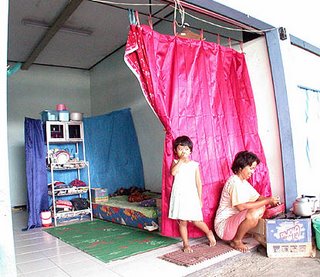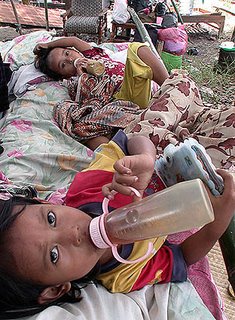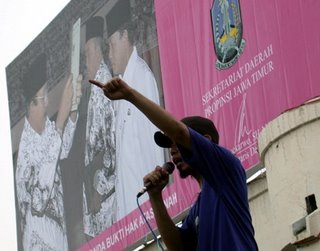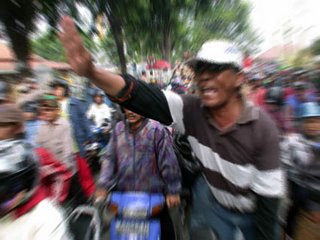
The Jakarta Post has publish this story on Monday, December 05, 2005
Despite having contracted Human Immunodeficiency Virus (HIV), there is no expression of fear on Sigit Sumargo's face. "All that I'm experiencing now is a consequence of my past deeds," said the 29-year-old Sigit (not his real name).
His agony began in 1994 when he became drug dependent. Since then, his life has been on a downward slide. His dependency on putaw (low-grade heroin) led him to criminal acts. He stole things from his house almost every day and sold them to the flea market -- jewelry, household utensils, and even the flag pole, which he sold for Rp 20,000 (US$2.00).
The only thing on his mind, he recollects, was how to get the money to buy the illicit substance. "What else could I sell, or who else could I cheat?" he recalled.
The habit only came to an end in 2002 after he became fed up of being dependent on drugs. "I was tired of telling lies and stealing," said Sigit, who was very active in student politics in the middle of the 1990s. He even joined a left-wing political party and was involved in activities to fight the Soeharto regime.
He recalled the decision to stop taking drugs was the hardest he had ever faced. He felt like every bone in his body was being poked with needles, the joints aching like they were trampled on by horses and various other pains in his body for more than a week.
But, then they were gone, and he felt the pleasure of being free from drugs. "After being free from drugs, I felt fresh waking up in the morning," said Sigit, a former basket ball player.
But, the suffering had not ended. Last year, he caught an illness that made his breathing difficult and it did not improve. He went to the hospital and the hospital found white specks on his lungs. The doctor suggested Sigit undergo a full medical checkup, including a HIV test.
The test results showed that he was HIV positive. Sigit recalls it was 2004 just a few days before Idul Fitri. "Frankly speaking, I was not surprised at all by the test results because I had realized it was a possibility and I accepted it," said the son of one of the caretakers of an Islamic boarding school in East Java.
He contracted HIV due to sharing needles among fellow addicts.
It was a terrible blow to his family. Provided with bottled water, bread and a cell phone, Sigit was left alone at the Infectious Diseases Intermediate facility, a clinic for HIV/AIDS patients at Dr. Soetomo hospital. In the beginning, the harsh response of his family enraged him. Initially he put all the blame on the family, but later he accepted their stance. Now, he accepts responsibility for his predicament.
His experience has led him to the awareness that he can do something for the community. In solidarity with people living with HIV/AIDS, Sigit has decided to stand up and become an active advocate of HIV/AIDS prevention.
Sigit is one of the 200 or so residents of Surabaya who have HIV. The actual number could be much higher and it should serve as a wake-up call as World AIDS Day is observed on Dec. 1. Based on data from the Surabaya Health Office in 2004, 217 people have contracted HIV, while 106 of them have Acquired Immunodeficiency Syndrome (AIDS). Data from 2003 shows that 99 people had contracted HIV, 49 of whom had AIDS.
Executive director of Hotline Surya, an NGO working with people with HIV, Esti Susanti, said that, learning from Sigit's case, it was clear that anyone could contract HIV/AIDS, from sex workers to even children from religious backgrounds. "Let there be no negative impression of people living with HIV/AIDS. Anyone can contract the virus," she told the Post.
She further said that besides support from the community, people living with HIV/AIDS could also be helped through antiretroviral therapy. With continued treatment the drugs can help improve immunity and increase the quality of life, allowing the person with HIV/AIDS to live longer.
--------------------
East Java bylaw to protect people living with HIV/AIDS
Friday, May 14, 2004
People living with AIDS in East Java can breathe a sigh of relief for, in the near future, East Java will have a bylaw that will protect them. The bylaw, which is slated to be the first in the country, will put an end to discrimination experienced by people living with HIV/AIDS (PLWHA).
Plans to put the bylaw into action were revealed following recent discussions between East Java legislative council Commission E and the organization People's Care for AIDS (MPA).
Commission E deputy speaker Lutfilah Masduki said after the meeting that the bylaw would stipulate penalties on those who discriminated against PLWHA in, for example, workplaces or schools. "If school authorities expel a student who has HIV/AIDS, they could be imprisoned for three months or fined Rp 3 million (US$350)," he said on Tuesday.
Separately, GAYa Nusantara gay rights organization chairman Budianto hailed the plan, saying that it would end discrimination against PLWHA. People who lead gay lifestyles are often perceived by the public as being associated with HIV/AIDS".
"I'm happy that the bylaw will be issued soon and hope it will be followed by concrete government action, such as providing low-cost medication to PLWHA and supplying low-cost condoms to the public as a preventive measure," said Budianto.
Besides, he added, the bylaw should also address widely held public prejudices that HIV/AIDS can be spread through conventional social interaction.
"People tend to think that HIV/AIDS can be spread through talking, kissing or meeting other people, but that's wrong. The realities should be set out clearly within the bylaw," he said.
Given that such prejudices have spread widely through society, it is hardly surprising that society, in turn, often ostracizes PLWHA, including their own families, he said.
HIV/AIDS cases at Dr. Sutomo Hospital, Jan to May, 2004
Children : 3 Adults : 226 Deceased : 180 Receiving treatment : 46
Source: Dr. Sutomo General Hospital (largest in Surabaya)
 Yuliana Thomas could only relish the memory of past Christmas celebrations, since the victim of the Sidoarjo, East Java mud disaster is now living in makeshift shelter at the Porong market.
Yuliana Thomas could only relish the memory of past Christmas celebrations, since the victim of the Sidoarjo, East Java mud disaster is now living in makeshift shelter at the Porong market.











